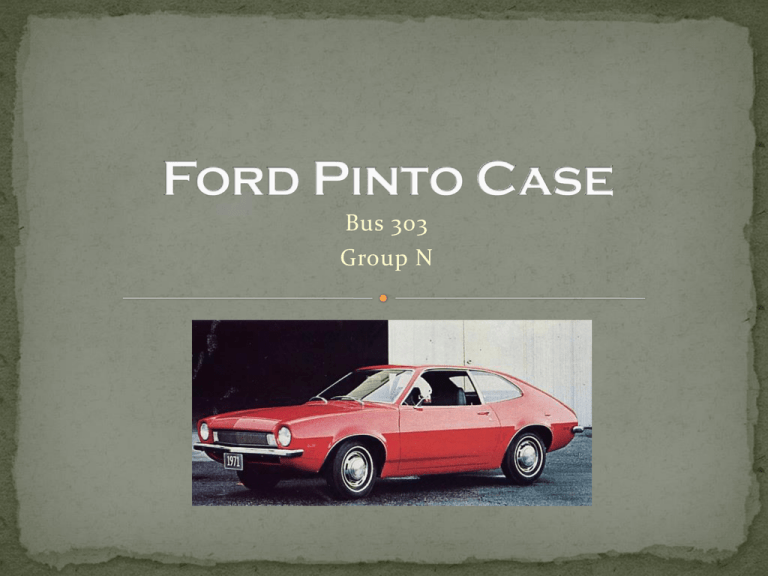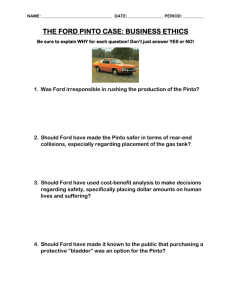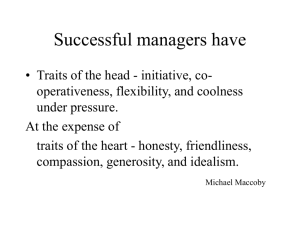Ford Pinto Case
advertisement

Bus 303 Group N Summary Cost Benefit Analysis Ethical Issues Change Alternatives Recommendation The Ford Pinto – a small car to compete with foreign car company competitors Pinto – weighed 2000 lbs and cost $2000 Rushed project led by Lee Iacocca Planning took 25 months compared to the industry norm 43 months Testing found several safety defects @ 25mph+ the gas tank would rupture in an accident @ 30mph+ rear endings would cause the gas tank to leak and the rear of the car to be folded up into the back seats @ 40mph+ the car doors would jam With Current Gas Tank With Safety Alteration 180 burn deaths Cost = $11 per vehicle 180 serious burns Total = $137 million 2100 Pintos burned Costs = $200 000 per death $67 000 per serious injury Second alternative = Rubber Bladder $700 per car Cost = $5.08 per vehicle Total = $49.5 million Total ~= $64 million Ford employees Lee Iacocca Henry Ford II Were they morally responsible to refuse to produce a car they knew would hurt the customer? Should they have put more effort into convincing Iacocca that this car was unsafe? Should they follow Iacocca’s commands regardless of their opinions since he is their superior in the company Is Iacocca responsible for the safety of his customers? Safety? What safety. Should he maximize profits for the company at any costs? If safety defects are found after production, does he have a moral obligation to inform all his customers? Should Iacocca have established a working environment where his employees did not feel that they would lose their jobs for disagreeing with him? Should Ford have trained his managers and presidents in safety? Does Ford have a responsibility to design a culture that encourages employees to bring up safety defects? Does Ford need to have a new policy that puts the has safety of their products more important than maximizing profits? Does Ford have a moral responsibility to do what is best for his shareholders Young and ambitious new president Foreign competitors entering N.A. market No small car to compete with VW Beetle and others The demand for results and profits are the most important aspect of business 1. Pay the $11 per vehicle 2. Explore different safety features 3. Restart the project from the planning process 4. Continue with production of the Pinto Pros Cons Repairs the safety defect High cost Saves Ford from potential Slight delay before launch lawsuits Protects Ford’s reputation Pros Cons A cheaper alternative could Pinto release would be be found Profit margin could be higher than first alternative Repairs the safety defect before launch delayed indefinitely Still decreases total profit Pros Cons Design can be more Significant delay of launch focused on safety Most costly alternative Improve Ford’s reputation Pros Cons Releases the Pinto to the Selling unsafe products to customers immediately customers – could lead to serious injuries and deaths The largest profit margin is obtained from each Pinto sale High chance of lawsuits against the company If/When injuries occur, loss of reputation Explore Other Safety Measures Repair the Pinto so that it is a cheap, safe car that will please the customers Act as a responsible company and not expose customers to unknown risks Implement a more cost effective option than adding the $11 safety addition Save lives by not releasing unsafe Pintos Ford workers were afraid to talk to Iacocca about the safety defects In Feb. 1978, Ford was sued for $128 million – more then 3 times the amount they had predicted May 1978 – Department of Transportation announces defects with the Ford Pinto – Ford recalls 1.5 million Pintos Mar. 1980 – Ford was charged with reckless homicide – acquitted of charges, however they stopped all Pinto production




